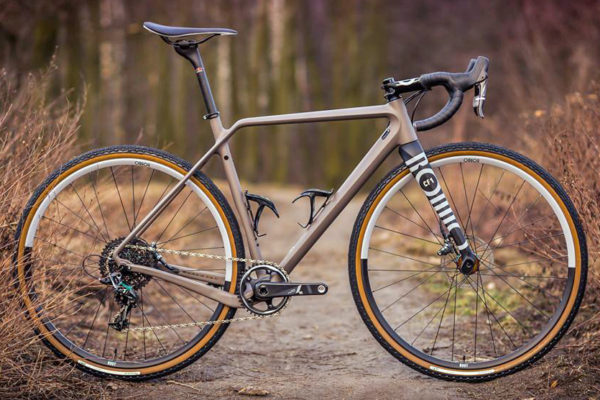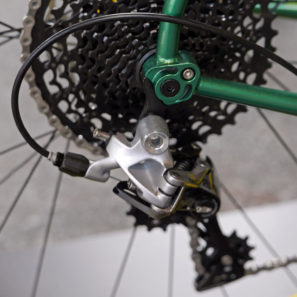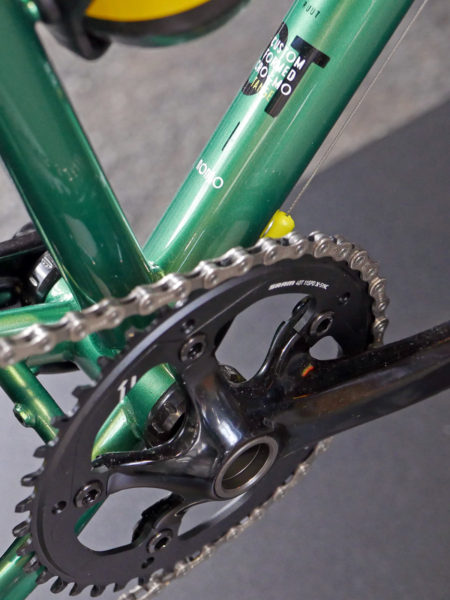Over the weekend in Berlin, new bike maker Rondo rolled out a broad new line of variable geometry Ruut gravel road bikes. Based around the same full carbon fork with a set of flip chips at the front thru-axle, the bikes can quickly swap back and forth between a paired setup of either endurance or race focused geometry. Combine that with a family of fat tire gravel road frames in either carbon, aluminum, or steel and the Gdansk-based company has a wide range of off-the-beaten-track bikes that can fit either 700c or 650b wheels…
Rondo as a company was founded by a couple of guys who had been working for other companies designing mountain bikes for more than a decade, and decide it was time to take those lessons learned and apply them to the growing gravel category that was still lacking much innovation. Sure gravel bikes have started offering the variable wheel size for a little while, but the variable geometry that has become common on top full-suspension mountain bikes could have a nice application off-road as well.
All of the Ruut (pronounced route, btw) bikes work off the same fork. The two position thru-axle at the fork tip allows Rondo to get what they call Vario Geo, offering either an endurance-focused ride, or a more race-oriented feel. By moving the axle up and down about 10mm, the headtube and seattube angles only shift by about 0.5° each. But of even greater impact is decreasing the bike’s trail by 13mm, lowering the bottom bracket (and your center of mass) by a few mm, and dropping the bar for a more aggressive fit. All of that means a noticeable change in the ride feel, so you can go from upright and relaxed, to more snappy yet stable handling just by flipping the chip.
Ruut CF1
At the top of the family is the Ruut CF1, with a full carbon fiber frameset that pairs most all you could want in a top of the line carbon gravel bike with the dual personality of the flip chip Vario Geo fork. The carbon frame itself gets a fairly rigid front triangle and large, asymmetric chainstays paired to a thin set of seatstays that loop behind the rear thru-axle dropouts and extend past the seattube to put more shock absorbing flex in the rear before it gets to your saddle.
The top CF1 will sell for 3700€ and come spec’d with a SRAM Force 1 hydro disc groupset, Rondo’s own color matched alloy 700c wheelset, Panaracer Gravel King 40mm tires, and Easton cockpit.
Of course besides the adjustable geometry trick, the Ruut family also takes advantage of the ability to run multiple wheel sizes. The founders come from a mountain bike background, and they clearly see this as a mountain biker’s do-it-all road bike. Each of the Ruuts can fit a 700c wheel with up to a 40mm tire, or go even bigger to a 650b wheel and up to 2.2″ tires.
All of the complete bikes we saw were setup for SRAM 1x drivetrains, but they do include a d set of bosses on the seattube to mount a removable front derailleur tab. They also all get modular internal cable routing and graphics to remind you to “Stop F-king Around” and ride your bike.
Ruut CF2

The Ruut CF2 shares the same frame and fork as the top bike, but brings the price down to 3000€ with a Rival 1 group.
Ruut ST
The steel framed Ruut ST shares the identical overall geometry and the same adjustable, 1.125″-1.5″ tapered carbon steerer fork as the more expensive carbon bikes but with a lower 2300€ price tag. The complete steel bike also gets built up with a Rival 1 hydraulic disc groupset with the same Rondo alloy wheels, but swaps in a less expensive crankset and some other down spec’d components to keep the price down.
The wide Ruut fork looks a bit broad for the thinner steel tubing, but the bike keeps the same wide tire flexibility and adjustable geometry. Out back Rondo worked hard to keep the chainstays just as short on the metal bikes, and sticks with a dropped asymmetric chainstay layout to make everything fit. There’s a good bit of tube shaping and crimping in there, but Rondo managed to make it all work out.
Out back the Ruut ST gets a machined thru-axle drop out that helps keep stiffness while keeping weight in check. The Tange chromoly frame opts for an external threaded BB (instead of the Press Fit on the carbon bike) and sticks with external downtube cable routing.
Ruut AL
The 6061 T6 aluminum framed bike is the most affordable option as part of the 1900€ Ruut AL. Again it shares the same geometry and adjustable fork as the other bikes. The complete alloy bike steps down to an Apex 1x group
Like the steel bike, the aluminum Ruut AL forgoes the kink in the toptube for a more traditional design better suited for an alloy bike.
The aluminum frame does keep the same asymmetric chainstay layout, and sticks with a threaded external bottom bracket. The larger tubing diameters also allows for a mixture of internal and external cable routing.
Each of the three different frame materials is available in the same four bike size range.
Geometry wise the fork offset gives any of the bikes the option of two different ride characters. Like most flip chip suspension mountain bikes, we thing that most riders will pick one position and leave it at that. But that’s not necessarily a bad thing. While many riders have gravitated to more upright, relaxed endurance geometry for gravel bikes, I personally have been a fan of a slightly quicker feel. This may just be a good option for riders who might otherwise be afraid to try a more road race geometry for fear of getting locked into quicker handling geometry for getting off the asphalt.
And you should be giving your bike some good cleaning and a once over a couple times a year. Why not be able to swap over to an endurance position for more relaxed winter riding, then back to something racier for the summer?
That’s a pretty big offering for a new company, but it is nice to see that they are offering a wide range of materials and price points from the get go. These new fat tire gravel bikes will go on sale later this spring, likely through a dealer network that is being finalized now, with availability of the bikes slated for June 2017.
And on top of that, we’ve heard rumor that they have a line of road bikes in the works too. Details are super thin on those, but we’re been told to expect something similar to the variable geometry, and still room for large volume road tires. We’ll definitely keep our eyes open for more info on Rondo and see when we can get ahold of one to ride…


















